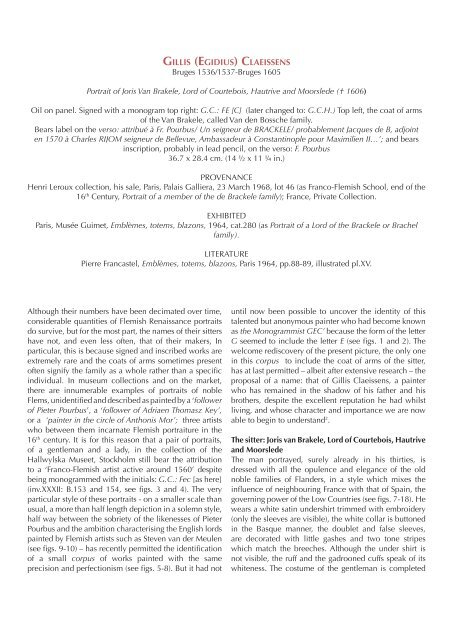Gillis (Egidius) Claeissens - Jean Luc Baroni
- No tags were found...
You also want an ePaper? Increase the reach of your titles
YUMPU automatically turns print PDFs into web optimized ePapers that Google loves.
<strong>Gillis</strong> (<strong>Egidius</strong>) <strong>Claeissens</strong><br />
Bruges 1536/1537-Bruges 1605<br />
Portrait of Joris Van Brakele, Lord of Courtebois, Hautrive and Moorslede († 1606)<br />
Oil on panel. Signed with a monogram top right: G.C.: FE [C] (later changed to: G.C.H.) Top left, the coat of arms<br />
of the Van Brakele, called Van den Bossche family.<br />
Bears label on the verso: attribué à Fr. Pourbus/ Un seigneur de BRACKELE/ probablement Jacques de B, adjoint<br />
en 1570 à Charles RIJOM seigneur de Bellevue, Ambassadeur à Constantinople pour Maximilien II…’; and bears<br />
inscription, probably in lead pencil, on the verso: F. Pourbus<br />
36.7 x 28.4 cm. (14 ½ x 11 ¼ in.)<br />
PROVENANCE<br />
Henri Leroux collection, his sale, Paris, Palais Galliera, 23 March 1968, lot 46 (as Franco-Flemish School, end of the<br />
16 th Century, Portrait of a member of the de Brackele family); France, Private Collection.<br />
EXHIBITED<br />
Paris, Musée Guimet, Emblèmes, totems, blazons, 1964, cat.280 (as Portrait of a Lord of the Brackele or Brachel<br />
family).<br />
LITERATURE<br />
Pierre Francastel, Emblèmes, totems, blazons, Paris 1964, pp.88-89, illustrated pl.XV.<br />
Although their numbers have been decimated over time,<br />
considerable quantities of Flemish Renaissance portraits<br />
do survive, but for the most part, the names of their sitters<br />
have not, and even less often, that of their makers, In<br />
particular, this is because signed and inscribed works are<br />
extremely rare and the coats of arms sometimes present<br />
often signify the family as a whole rather than a specific<br />
individual. In museum collections and on the market,<br />
there are innumerable examples of portraits of noble<br />
Flems, unidentified and described as painted by a ‘follower<br />
of Pieter Pourbus’, a ‘follower of Adriaen Thomasz Key’,<br />
or a ‘painter in the circle of Anthonis Mor’; three artists<br />
who between them incarnate Flemish portraiture in the<br />
16 th century. It is for this reason that a pair of portraits,<br />
of a gentleman and a lady, in the collection of the<br />
Hallwylska Museet, Stockholm still bear the attribution<br />
to a ‘Franco-Flemish artist active around 1560’ despite<br />
being monogrammed with the initials: G.C.: Fec [as here]<br />
(inv.XXXII: B.153 and 154, see figs. 3 and 4). The very<br />
particular style of these portraits - on a smaller scale than<br />
usual, a more than half length depiction in a solemn style,<br />
half way between the sobriety of the likenesses of Pieter<br />
Pourbus and the ambition characterising the English lords<br />
painted by Flemish artists such as Steven van der Meulen<br />
(see figs. 9-10) – has recently permitted the identification<br />
of a small corpus of works painted with the same<br />
precision and perfectionism (see figs. 5-8). But it had not<br />
until now been possible to uncover the identity of this<br />
talented but anonymous painter who had become known<br />
as the Monogrammist GEC’ because the form of the letter<br />
G seemed to include the letter E (see figs. 1 and 2). The<br />
welcome rediscovery of the present picture, the only one<br />
in this corpus to include the coat of arms of the sitter,<br />
has at last permitted – albeit after extensive research – the<br />
proposal of a name: that of <strong>Gillis</strong> <strong>Claeissens</strong>, a painter<br />
who has remained in the shadow of his father and his<br />
brothers, despite the excellent reputation he had whilst<br />
living, and whose character and importance we are now<br />
able to begin to understand 2 .<br />
The sitter: Joris van Brakele, Lord of Courtebois, Hautrive<br />
and Moorslede<br />
The man portrayed, surely already in his thirties, is<br />
dressed with all the opulence and elegance of the old<br />
noble families of Flanders, in a style which mixes the<br />
influence of neighbouring France with that of Spain, the<br />
governing power of the Low Countries (see figs. 7-18). He<br />
wears a white satin undershirt trimmed with embroidery<br />
(only the sleeves are visible), the white collar is buttoned<br />
in the Basque manner, the doublet and false sleeves,<br />
are decorated with little gashes and two tone stripes<br />
which match the breeches. Although the under shirt is<br />
not visible, the ruff and the gadrooned cuffs speak of its<br />
whiteness. The costume of the gentleman is completed
















